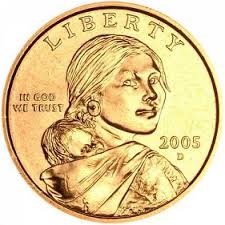A 2000-P Sacagawea dollar or Type l (no rim) planchet which is literally blank is worth $500. Another 2000-P Sacagawea dollar struck with 30 percent off center usually costs $3,500. A 2000-P dollar struck 25 percent off center on a 30 percent straight off clip is worth $1,750. The 2000-P 'Wounded Eagle' Sacagawea Dollar is so-named because of a raised die flaw that cuts across the eagle's belly (see the attribution image above). PCGS is not responsible for the accuracy or authenticity of Ebay listings. Sacagawea Dollars The Sacagawea Golden Dollar was first issued in the year 2000. In 2009 the series under went a change to honor Native Americans and assumed the title of the Native American Dollar Coin. We carry brilliant uncirculated specimens of these coins as well as proof versions. The Sacagawea Dollar series began in 2000 and is named after the Native American woman who appears on its obverse. The Presidential Dollar series began in 2007, using the same planchets as the. Sacagawea / Native American Dollar Books 2020 Red Book - Guide Book of United States Coins Cherrypickers Guide to Rare Die Varieties. Eagle Reverse (2000 - 2008).
Sacagawea gold dollar coins were minted first from 2000 until 2008 and again with different reverse designs starting in 2009. These are popular coins but well over a billion have been minted since 2000. There are a couple of special varieties that are collectible like the 2000-P Cheerios coin. However, your regular strike Sacagawea coins are still just worth $1 and will likely only be worth a dollar for the foreseeable future. A moderate exception would be that some of the older rolls do sell for a very small premium over their face value. All Sacagawea coins, while gold in color, have absolutely no precious metals value. They are made of copper, manganese, brass, zinc, and nickel. Despite their limited collector value, Sacagaweas are still a fun coin with a lot of history.
Our guide at the bottom of this page lists the mintage figures and historical information about all the various Sacagawea coins from different years. Here are some quick facts that collectors might find of interest:
-The legal authorization to mint a new dollar coin was passed in 1997, but the first coins were not released until January 2000.
-The general public actually preferred a coin showing the statue of liberty, but the Sacagawea design was selected by the officials in charge of the coin. Thanks to the coin, today Sacagawea is widely recognized. She was certainly not a household name in the late 1990s before the coin was released to the public.
-No images of the actual person Sacagawea exist (she died in 1812). The woman pictured on the coin is actually a 22 year old college student named Randy'L He-dow Teton.
-Most Sacagaweas are used in the United States in vending machines or hoarded by collectors who hope the coins will someday be worth a lot of money. We don't see the coins too much in commerce for that reason. However, the USD is an official currency in Ecuador and Sac dollars are the preferred day to day denomination in Ecuador.
Design 2000-2008:
Sacagawea has her infant in a papoose over her shoulder. Her son was named Jean Baptiste Charbonneau. The back of the coin features a more familiar design. It has a flying eagle, 17 stars, and the traditional text of E Pluribus Unum – United States of America – One Dollar. The front of the coin says LIBERTY and In God We Trust. There will be a P, D, or S mint mark under the year. And the back of each coin also has the initials TDR for Thomas D. Rogers Sr, the mint sculptor and engraver.
Remember the excitement over the Sacagawea coin? If you were in any way involved with the coin collecting community in 2000, you may recall the buzz surrounding the long-anticipated release of the Sacagawea dollar coin. The Sacagawea golden dollar was supposed to fix all of the problems associated with the Susan B. Anthony dollar, which had been released in 1979 but quickly failed to circulate. By 1981, the coin was in production only for coin sets. Later that year, the SBA dollar was retired. It was minted again one last time in 1999, when dollar coins were seeing circulation in the postage stamp machine circuit and some mass transit systems.
The rise use of the dollar coin in the late 1990s brought many in the numismatic community to believe that Sacagawea dollar coin would be a success. Yet, despite efforts and a massive public outreach campaign by the United States Mint encouraging the use of the new dollar coins, the Sacagawea coin failed to gain acceptance. One thing is for sure – the failure of the Sacagawea coin to widely circulate wasn't due to confusion of the coin with the quarter-dollar, which was part of the downfall for the Susan B. Anthony dollar in the early 1980s.
Designing the Sacagawea Coin

Glenna Goodacre designed the obverse design for the Sacagawea dollar coin. Featuring a portrait of Shoshone woman Sacagawea, who accompanied Lewis and Clark on their 1804-06 expedition throughout what would become the western United States, the dollar became the first circulating U.S. Bing giving robux. coin to feature the figure of a Native American in decades; the Buffalo nickel, which features an obverse depiction of a Native American, was struck from 1913 through 1938.

As Goodacre didn't have any contemporary portraiture of Sacagawea to use in creating the design, she asked a 22-year-old Shoshone woman named Randy'L He-Dow Teton to pose as a model for the coin. Goodacre also included an image of Jean Baptiste Charbonneau, Sacagawea's newborn son, on the dollar coin design.
Additionally, the Sacagawea dollar coin features a distinctive golden color. Many people outside of the coin collecting community originally thought Sacagawea dollar coins actual gold. Of course, that couldn't be the case given the high bullion value of gold.
What Makes the Sacagawea Golden Dollar 'Golden'?
The coin's metallic composition includes a pure copper core with an outer layer consisting of manganese brass (77% copper, 12% zinc, 7% manganese, and 4% nickel).
The Sacagawea dollar coin weighs 8.1 grams, which makes it heavier than any coin that was widely circulating in 2000, when the series was released; it should be noted that copper-nickel half dollars weigh 11.34 grams, but half dollars were not widely circulating in 2000, making the quarter the next-heaviest circulating denomination at the time, at 5.67 grams.
What Happened to the Sacagawea Dollar Coin?


Glenna Goodacre designed the obverse design for the Sacagawea dollar coin. Featuring a portrait of Shoshone woman Sacagawea, who accompanied Lewis and Clark on their 1804-06 expedition throughout what would become the western United States, the dollar became the first circulating U.S. Bing giving robux. coin to feature the figure of a Native American in decades; the Buffalo nickel, which features an obverse depiction of a Native American, was struck from 1913 through 1938.
As Goodacre didn't have any contemporary portraiture of Sacagawea to use in creating the design, she asked a 22-year-old Shoshone woman named Randy'L He-Dow Teton to pose as a model for the coin. Goodacre also included an image of Jean Baptiste Charbonneau, Sacagawea's newborn son, on the dollar coin design.
Additionally, the Sacagawea dollar coin features a distinctive golden color. Many people outside of the coin collecting community originally thought Sacagawea dollar coins actual gold. Of course, that couldn't be the case given the high bullion value of gold.
What Makes the Sacagawea Golden Dollar 'Golden'?
The coin's metallic composition includes a pure copper core with an outer layer consisting of manganese brass (77% copper, 12% zinc, 7% manganese, and 4% nickel).
The Sacagawea dollar coin weighs 8.1 grams, which makes it heavier than any coin that was widely circulating in 2000, when the series was released; it should be noted that copper-nickel half dollars weigh 11.34 grams, but half dollars were not widely circulating in 2000, making the quarter the next-heaviest circulating denomination at the time, at 5.67 grams.
What Happened to the Sacagawea Dollar Coin?
Nowadays, the Sacagawea golden dollar coin, like the half dollar, fails to circulate. In fact, Sacagawea dollars haven't been struck for circulation since 2001. Doubtlessly, the reason dollar coins don't circulate well these days is because they don't have to – the dollar bill siphons away any logistical need for using a dollar coin. Paisley billings gala bingo center. It's widely theorized that if the dollar coin was put into production and the dollar bill was pulled from commerce, people would widely use the dollar coin through force. A similar scenario happened in Canada during the late 1980s, when that nation transitioned away from using dollar bills and replaced them with small-size, gold-colored 'Loonie' dollar coins.
In 2009, the reverse of the Sacagawea dollar coin has been used to display special, annually changing designs depicting key figures and moments in Native American history. These designs will be used for the duration of the Presidential dollar coins, which were first struck in 2007 and are slated to end in 2016.
Sacagawea Coin Values
Sacagawea Dollar Error
Standard uncirculated Sacagawea dollar coins are worth $2 to $3, with proofs selling for $10 to $15. The 2000 Goodacre presentation finish Sacagawea coins were struck in a very small quantity (5,000 pieces) and are worth around $600 each.
The 2001-S and 2002-S proof Sacagawea dollar coins are worth $50 and $25 respectively.
Sacagawea Dollar Cheerios
Related Posts
What Are Mint State Coins?
Sacagawea Dollar Error No Date
Delaware Dollars Kick Off American Innovation $1 Coin Series
Sacagawea Dollar 2000 D
2019 Palladium American Eagle Bullion Coins Offer Investors A New Alternative
Sacagawea Dollar 2000-d
By accepting you will be accessing a service provided by a third-party external to https://coinvalues.com/
